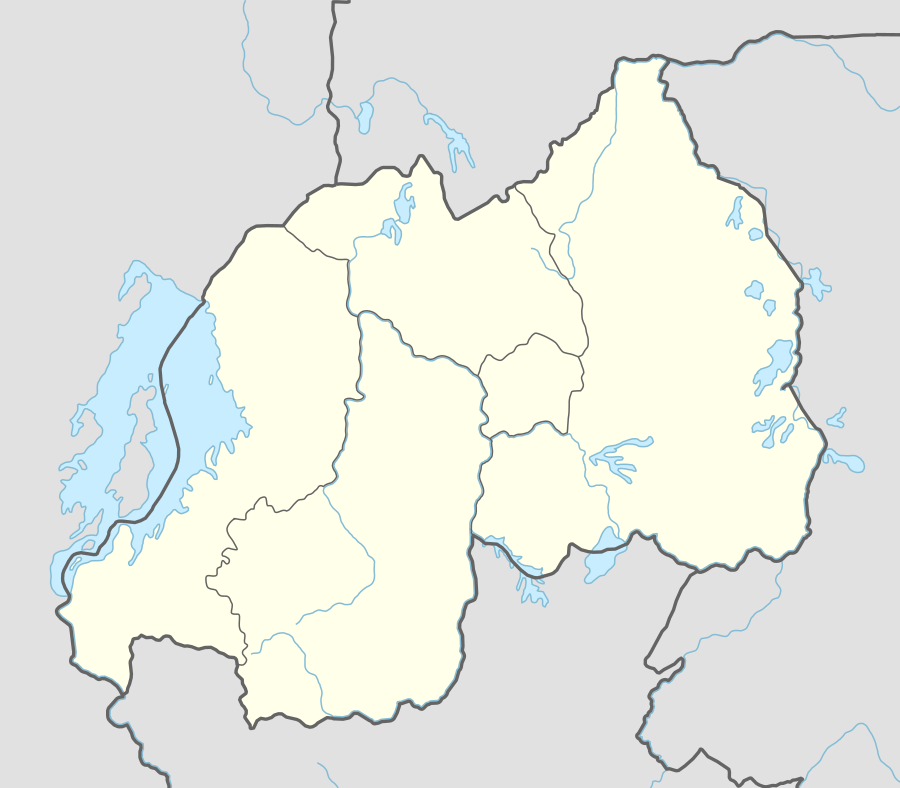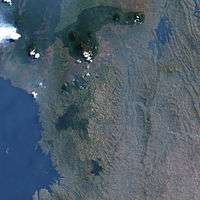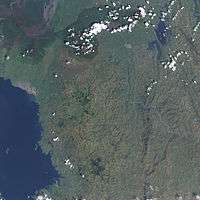Gishwati Forest
is a protected reserve in the north-western part of Rwanda, not far from Lake Kivu. The reserve’s forests were largely intact in 1978, and substantial forest cover still remained in 1986.[1] During the Rwandan genocide, wave after wave of refugees arrived in Gishwati Forest and began clearing it, often for subsistence farming. By 2001, only a small circular patch of native forest remained, 1,500 acres (6.1 km2) of the forest’s original 250,000.[1] In addition to tremendous loss of biodiversity, the region experiences soil erosion and degradation and landslides.[1] Reforestation efforts in the past few years have increased the remnant native forest to about 2,500 acres (10 km2).[1] Large tea estates occupy the central and northern parts of the reserve.[1]

Gishwati Forest Reserve
History
The Gishwati Forest used to be one piece in a complex system of rainforests through the middle of Africa. It used to extend west beyond Lake Kivu connecting with the rainforests of the Congo, and south connecting with Nyungwe Forest.[2] These forest systems have become fragmented due to population increase and deforestation. The Rwandan genocide put strain on the site as refugees fled and the population increased as people were displaced from their homes; however the area had faced years of degradation prior to the Rwandan genocide. The area was degraded for cattle ranching and agriculture until it became unproductive. Erosion, landslides, reduced water quality, and soil infertility had resulted from this degradation of the land.
The Gishwati Area Conservation Program (GACP) began in 2007 with the collaboration of Rwandan president, Paul Kagame, and Great Ape Trust, founded by philanthropist Ted Townsend. The initiative began with the idea of creating a national conservation park in Rwanda to protect the biodiversity of the Gishwati Forest area and stop some of the rapid degradation. In 1930 the Gishwati Forest covered 70,000 acres but lost about 90 percent of its cover, this initiative aimed to restore the dramatic loss the area has seen over the last decade and therefore named the site the Forest of Hope.[3] In 2011, the GACP was succeeded by a Rwandan non-governmental organization known as the Forest of Hope Association,[4] which is currently managing the Gishwati Forest Reserve (GFR).
Since the Forest of Hope has been in place there has been a 67 percent increase in size of the Gishwati Forest. The local chimpanzee population has grown and many research and conservation initiatives have been employed within the reserve. The Gishwati Area Conservation Program began with the hopes that down the road the Rwandan government would take over the area make it a national park. Some government actions and press coverage suggests that GFR will be promoted to national park status in the near future.[5]


Biodiversity
Due to the deforestation of the Gishwati forest, serious loss of biodiversity has resulted. Fauna alone has declined by 99.7%. Flora that play an important role in the lives of the native people have also seen significant decline. Wild fruits have declined by 93.3%, wild vegetables have declined by 99.6%, and wild medicines used by the native people have declined by 79.9%.[6]
The forest reserve has recorded 58 species of trees and shrubs, including numerous indigenous hardwoods and bamboo.[7] A recent study of carbon sequestration of the forest indicated Macaranga kilimandscharica to be the most common species of tree in areas of the forest that have not been disturbed. Previously disturbed regions of the forest experiencing regeneration show colonization of Carapa grandiflora, Entandrophagrama excelsum, and Symphonia globulifera.[6] Other flora of the reserve include giant tree ferns and blue lichen.[8]
A wide range of fauna can be found within the reserve. Four species of primates are found, the Eastern Chimpanzee (Pan troglodytes schweinfurtii), the golden monkey, the blue monkey, and the L'Hoest's monkey (also known as mountain monkey). Though not since 2002, a fifth species of primate, the black and white colobus has been reported having been seen. There are currently estimated to be 20 East African chimpanzees in the forest. This is a 54% increase in population size from the 13 chimps in 2008, when the GACP first started. This includes five infants.[9] The average density of chimpanzee nests was found to be 1.473 per km2 by Dr. Plumptree.[10] Other mammals include the red river hog (Potamochoerus porcus), the black front duiker (Cephalophus nigrifrons), the southern tree hyrax (Dendrohyrax arboreus), the serval (Felis serval), and Felis aurata.[6]
Other fauna found are the 84 species of birds, including Woodhoopoes (Phoeniculidae), White-headed Woodhoopoe (Phoeniculus bollei), Old World Warblers (Sylviidae), and Mountain Yellow Warbler (Iduna similis).[11] The brown forest frog along with multiple species of toads are some of the amphibian life found in the forest. With respect to reptiles, the great lakes bush viper and multiple species of chameleons are also found live in the Gishwati forest.[8]
Conservation
A small isolated group of east African chimpanzees inhabits the Gishwati forest, a place that may serve as a test bed for new conservation approaches and ideas. By 2008 the population had been reduced to thirteen members and was on the brink of extinction. Between 2008 and 2011 the population increased by forty-six percent to nineteen members through the efforts of Rwandan government and the Gishwati Area Conservation Program. Efforts like those established to help Gishwati’s great apes may be instrumental in helping great apes around the world.[12] Gishwati forest is the livelihood of hundreds of thousands of Rwandans who live around Gishwati. The forest helps maintain the topsoil’s fertility and keeps it from eroding away. In the future it may provide the Rwandan economy with profits from ecotourism through the biodiversity found in the area.[13]
Plant-It 2020
In 2011, Plant-It 2020 provided funding for the Gishwati Area Conservation Program of the Great Ape Trust to plant 1,000 native trees in and around the Gishwati National Forest in western Rwanda.[14] Plant-It 2020 is a nonprofit international reforestation foundation that was founded by the late singer John Denver.[15]
Gishwati Forest and Nyungwe National Park corridor
A 10,000 acre corridor of newly planted trees may one day connect Gishwati Forest and Nyungwe National Park, about thirty miles to the south. This connection will allow animals to migrate between the protected areas and insure the gene flow of alleles between both populations of chimpanzees. The project has received government support from Rwandan Ministry of Lands and Environment because the new forest cover will improve water catchment and water purification, prevent soil erosion, replenish soil fertility, and support ecotourism.[16]
References
- "Gishwati Forest". NASA Earth Observatory. Retrieved 2009-09-012. Check date values in:
|accessdate=(help) - "Rwanda's Gishwati Forest expected to be elevated to national park status in 2012/13 financial year". DAILY from Eastern Africa and the Indian Ocean islands. Retrieved 4/11/2012. Check date values in:
|accessdate=(help) - "About Forest of Hope". Great Ape Trust. Archived from the original on 2012-04-18. Retrieved 4/10/2012. Check date values in:
|accessdate=(help) - "Forest of Hope Association". Forest of Hope Association, Rwanda. Retrieved 1 May 2014.
- "Gishwati-Mukura forest to become national park". Retrieved 26 June 2015.
- Kironde, Elizabeth. "Rwanda State of Environment and Outlook 2009" (PDF). Rwanda Environmental Management Authority. Retrieved 13 April 2012.
- "Strengthening Biodiversity Conservation Capacity in the Forest Protected Area System of Rwanda" (PDF). United Nations Development Programme: Global Environment Facility. Archived from the original (PDF) on 11 May 2012. Retrieved 13 April 2012.
- "Gishwati Area Conservation Program Gets Support for Planting 1,000 Trees". Great Ape Trust. Archived from the original on 23 April 2012. Retrieved 13 April 2012.
- "Rwanda: Endangered Chimpanzee Population Increases in Forest of Hope". African Conservation Foundation. Archived from the original on 12 August 2011. Retrieved 13 April 2012.
- Barakabuye, N.; Mulindahabi, F.; Plumptre, A.J.; Kaplin, B.; Munanura, I.; Ndagijimana, D.; Ndayiziga, O. (2007). "Conservation of Chimpanzees in the Congo nile divide forests of Rwanda and Burundi". WCS, ORTPN, INECN.
- "Gishwati Forest Reserve". Internet Bird Collection. Retrieved 13 April 2012.
- "Meet the Chimpanzees". Archived from the original on 19 March 2012. Retrieved 11 April 2012.
- "Valuing Conservation?". 2012 Great Ape Trust. Archived from the original on 12 September 2011. Retrieved 11 April 2012.
- "Plant-It 2020". Retrieved 4 May 2012.
- "Gishwati Area Conservation Program Gets Support for Planting 1,000 Trees". Great Ape Trust. Archived from the original on 12 September 2011. Retrieved 9 April 2012.
- "Wildlife Corridor". 2012 Great Ape Trust. Archived from the original on 2011-09-12.
External links
| Wikimedia Commons has media related to Gishwati Forest. |